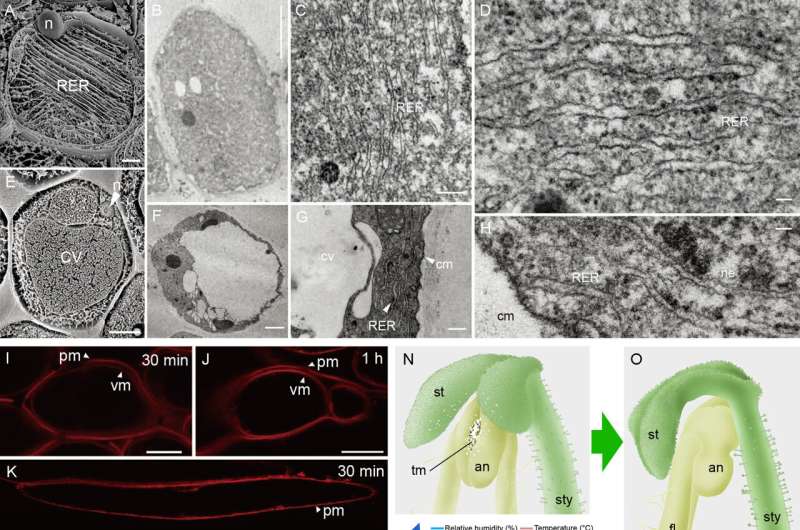This article has been reviewed according to Science X's editorial process and policies. Editors have highlighted the following attributes while ensuring the content's credibility:
fact-checked
trusted source
proofread
Study finds new type of cell related to organ movement for self-pollination in plants

A study led by Dr. Yin-Zheng Wang (Institute of Botany, the Chinese Academy of Sciences) has found that the stigma of Chirita pumila has movement and proved that the motion is associated with water sensitivity. Further, through anatomical studies, it was found that when the stigma absorbed water, a type of cell accounting for half of the volume of the stigma was greatly extended, which was closely related to the extension-contraction movement of the stigma. The new cells are named contractile cells.
The research group found that contractile cells are filled with reticular structures and the nuclei were squeezed to the edges, whereas parenchyma cells are comprised of mainly large central vacuoles. After absorbing water, the contractile cells greatly elongate to more than eight times, still filled with a network structure. This shows that the reticular structure is the main mechanism of water sensitivity, that is, the reticular structure water absorption and expansion drive contraction cell elongation, resulting in stigma movement.
CLSM showed that FM4-64 fluorescence signals migrated from the plasma membrane to the vacuole membrane in the parenchyma cells, but there was no vacuole membrane signal in contractile cells, and the weak signals at different wavelengths of red and green showed a large elongation of the contractile cells.
The absence of vacuoles in the contractile cells confirms that the water-sensitive substance that absorbs water and expands is a network structure, not a vacuole. TEM and fluorescence signal analysis revealed that the network structure was caused by endoplasmic reticulum with granular ribosomes, which was completely different from parenchyma cells. RNA-seq analysis showed that the expression profiles of constricted cells were significantly different from those of parenchyma cells.
Through field observation the authors further found that the stigma of the plant showed a bidirectional opening and closing—bending movement, and the contractile cells drove the stigma circadian rhythm with changes in humidity. In addition, the stigma movement leaves a pollen channel connecting the anther gap between the two stigma lobes, which continuously squeezes the anther, causing pollen to be forced directly to the receptive surface of the stigma through this channel.
Thus, the movement of the stigma transforms a floral system based on cross-pollination by insects into one of strict self-pollination. This reproductive strategy involving the transition from outcrossing to predominant self-pollination has likely evolved because of the uncertain environment for cross-pollination by insects in which Chirita pumila occurs and represents a novel proximate mechanism of reproductive assurance.
The research is published in the journal National Science Review.
More information: Yin-Zheng Wang et al, A new type of cell related to organ movement for selfing in plants, National Science Review (2023). DOI: 10.1093/nsr/nwad208
Provided by Science China Press




















